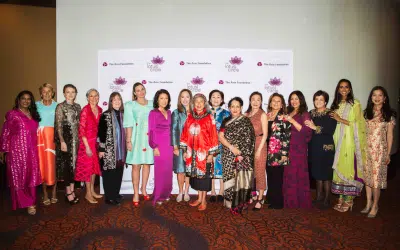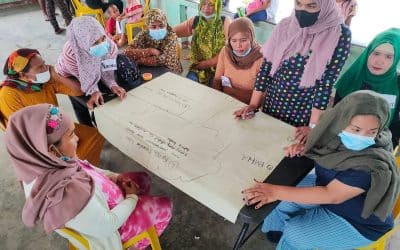InAsia
Insights and Analysis
The Promises and the Pitfalls of Tech in the Asia-Pacific
September 27, 2023

(Photo: The Asia Foundation)
A wave of digital technologies has revolutionized the Asia-Pacific region, transforming societies, economies, and the fabric of life. This digital wave has swept almost the entire region, from its bustling metropolises to its remote corners and distant islands, bringing unprecedented opportunities for prosperity, connectivity, and access to information while also presenting daunting challenges to peace and security, human rights, democracy, and development.
At the center of this technological revolution is an intricate conversation between digital technologies and digital rights—fundamental human rights, extended into the digital sphere—including the core principles of privacy and data protection, freedom of expression, access to information, and the freedom to assemble and associate online. The question at the heart of this conversation is this: how can we harness the boundless potential of technology to advance flourishing societies while navigating and neutralizing its inherent drawbacks?
Last May, in Chiang Mai, Thailand, the Digital Rights Asia-Pacific 2023 Assembly (DRAPAC23) brought together a broad array of experts for an exchange of views that showcased both optimistic “tech-solutionist” and pessimistic “tech-problematizing” perspectives. Their views shed light on technology’s promises and pitfalls, its profound impact on politics and society, and the myriad realities of a digital realm where the fortunate can benefit from cutting-edge tech while the poor and marginalized struggle for basic digital access and are often hurt by online activities.

A session by the Resiliency Initiative, “Enabling CSOs to Tackle Intolerance and Promote Peace through Social Media,” at DRAPAC23. (Photo: The Asia Foundation)
A new frontier of manipulation and repression
In many Asia-Pacific nations, online spaces have become a new frontier of human rights violations, violence, and conflict, where political actors often adopt digital repression as a core political strategy.
Internet censorship and surveillance have become common, stifling freedom of expression as social media platforms become breeding grounds for manipulation. Governments and nonstate actors employ social media influencers as “cyber troops” to shape public opinion on controversial issues, at times weaponizing internet access for control and as a shield for impunity. Tactically deployed internet shutdowns facilitate ongoing human rights violations by limiting communications and access to vital information, education, and social support networks.
The Asia-Pacific region is also experiencing the spread of online disinformation, which is polarizing politics and fraying the social fabric. During elections and crises, crafted narratives and rumors are used to tarnish opponents, erode trust in institutions, and amplify social tensions by manipulating long-standing stereotypes and biases against specific groups, particularly ethnic and religious minorities.
Amidst these concerning developments, social media algorithms have intensified social polarization. Social media platforms employ algorithms that curate content to maximize user engagement (creating “virality”). This often turns users’ news feeds into echo chambers, where they are presented with content that reinforces their existing beliefs and biases and reduces their exposure to alternative voices.
The combination of digital repression, disinformation, and algorithmic curation creates a potent brew that threatens human rights, both offline and online. The repercussions are far-reaching, challenging the essence of freedom of expression, access to information, and the right to participate in democratic discourse.
A struggle for inclusion: connecting the unconnected
In theory, digital rights are not a luxury reserved for tech-savvy urban dwellers; yet, a digital divide emerges in practice, a digital literacy gap that affects people’s ability to navigate online platforms, access digital services, and exercise their rights.
The digital divide leaves marginalized populations unconnected, entrenching systemic inequalities. With limited access to the internet and information technology, and sometimes facing language barriers, “unconnected” individuals struggle to engage in civic activities or to access government services and economic opportunities such as online job markets, education, and e-commerce.
Gender inequality is another aspect of the digital divide. Women and girls in many areas face cultural norms and economic constraints that prevent them from accessing digital resources and opportunities, hindering their participation in the economy and the community.
Digital activism and civic engagement
The leading role of civil society in protecting digital rights and fostering an inclusive digital environment in the Asia-Pacific region was clearly on display at DRAPAC23:
- Civic leaders and campaigners are raising awareness of digital threats, including censorship and surveillance, through notable projects such as Advox’s Unfreedom Monitor and the Digital Defenders Partnership’s Digital Protection Accompaniment program. Focusing on reporting, advocacy, and mobilization, such initiatives are exposing the effects of repressive tactics and empowering human rights defenders with information and digital security training.
- Initiatives like Common Room’s Digital Mapping Workshop and the Google–Asia Foundation collaboration Go Digital ASEAN are trying to bridge the digital divide by providing connectivity and reducing inequalities through community-based internet infrastructure and digital literacy programs.
- Safeguarding digital rights, particularly for journalists working under authoritarian regimes, remains a significant concern. Media organizations such as Free Press Unlimited and Exile Hub share insights, best practices, and digital security strategies. They stand as strong advocates for protecting journalists’ rights and safety and upholding online freedom of expression.
- Addressing online gender-based violence and the limited internet access experienced by women in many countries, local NGOs such as Malaysia’s EMPOWER and the Philippines’ Foundation for Media Alternatives advocate policy changes that prioritize women’s needs.
- Tech-savvy, youth-led organizations such as Hashtag Generation in Sri Lanka and Save Youth in Bangladesh are combating online hate speech and disinformation by promoting digital activism through social media campaigns and community engagement.
Paving the way forward
The Asia-Pacific region has experienced rapid development driven by industrialization, demographic dividends, and improvements in education and infrastructure. Today, digital technologies have become an integral part of the region’s development trajectory.
The surge in online activity presents both opportunities and challenges, requiring the collective effort of stakeholders to secure a future where human rights can thrive. Governments must promote digital inclusion and protect digital rights by developing infrastructure, digital literacy programs, and legislation that addresses malicious or illegal content. Civil society organizations and technology innovators must work to foster safe, inclusive, and equitable digital ecosystems.
Phet Sayo, executive director of Engage Media, believes that civil society can champion the mass adoption of digital technology while still remaining vigilant in protecting online human rights. “We don’t have to trade positive benefits for negative impacts,” Sayo told the DRAPAC23 audience, but “there’s a great deal of work for us to do.”
DRAPAC23 was an impressive effort to expand the digital rights movement in the region. It fostered face-to-face connections and engaged young advocates, allowing diverse actors to exchange knowledge, collaborate, and forge a shared vision of a rights-respecting digital future.
Naruemol Tuenpakdee is a regional program officer in The Asia Foundation’s Conflict and Fragility program, and Micheline Rama is a social behavior change consultant for The Asia Foundation’s Law and Human Rights program. They can be reached at [email protected] and [email protected], respectively. The views and opinions expressed here are those of the authors, not those of The Asia Foundation.
About our blog, InAsia
InAsia is posted and distributed every other Wednesday evening, Pacific Time. If you have any questions, please send an email to [email protected].
Contact
For questions about InAsia, or for our cross-post and re-use policy, please send an email to [email protected].The Asia Foundation
465 California St., 9th Floor
San Francisco, CA 94104
The Latest Across Asia
News
April 25, 2024
Program Snapshot
April 18, 2024
News
April 17, 2024

2024 Lotus Leadership Awards
The Lotus Leadership Awards recognize contributions towards gender equality in Asia and the Pacific







0 Comments